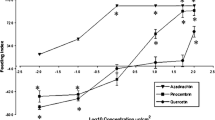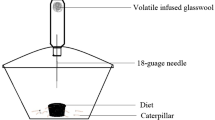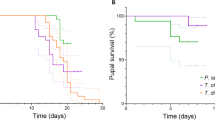Abstract
The host plants of the native American butterfly, Pieris napi oleracea, include most wild mustards. However, garlic mustard, Alliaria petiolata, a highly invasive weed that was introduced from Europe, appears to be protected from this insect. Although adults will oviposit on the plant, most larvae of P. n. oleracea do not survive on garlic mustard. We used feeding bioassays with different larval stages of the insect to monitor the isolation and identification of two bioactive constituents that could explain the natural resistance of this plant. A novel cyanopropenyl glycoside (1), alliarinoside, strongly inhibits feeding by first instars, while a flavone glycoside (2), isovitexin-6″-D-β-glucopyranoside, deters later instars from feeding. Interestingly, the first instars are insensitive to 2, and the late instars are little affected by 1. Furthermore, differential effects of dietary experience on insect responses suggest that 1 acts through a mechanism of post-ingestive inhibition, whereas 2 involves gustatory deterrence of feeding.
Similar content being viewed by others
REFERENCES
BELL, R. A., OWENS, C. D., SHAPIRO, M., AND TARDIF, J. R. 1979. Development of mass rearing technology, pp. 599–633, in C. C. Doane and M. L. McManus (eds.). The Gypsy Moth: Research Toward Integrated Pest Management. USDA-FS Technical Bulletin 1584.
BOWDEN, S. R. 1971. American white butterflies (Pieridae) and English food plants. J. Lepidopterists' Soc. 25:6–12.
CHEW, F. S. 1981. Coexistence and local extinction in two Pieris butterflies. Am. Nat. 118:655–672.
CHEW, F. S. 1988. Searching for defensive chemistry in the Cruciferae, or, do glucosinolates always control interactions of Cruciferae and their potential herbivores and symbionts? No! pp. 81–112, in K. C. Spencer (ed.). Chemical Mediation of Coevolution, Academic Press, San Diego.
CHEW, F. S., and RENWICK, J. A. A. 1995. Host-plant choice in Pieris butterflies, pp. 214–238, in R. T. Cardé and W. J. Bell (eds.). Chemical Ecology of Insects 2. Chapman and Hall, New York.
DIMOCK, M. B., RENWICK, J. A. A., RADKE, C. D., and SACHDEV-GUPTA, K. 1991. Chemical constituents of an unacceptable crucifer, Erysimum cheiranthoides, deter feeding by Pieris rapae. J. Chem. Ecol. 17:525–533.
EHRLICH, P. R., and RAVEN, P. H. 1964. Butterflies and plants: A Study in Coevolution. Evolution 18:586–608.
FEENY, P. 1977. Defensive ecology of the Cruciferae. Ann. Missouri Bot. Gard. 64:221–234.
FRAZIER, J. L. 1991. Howanimals perceive secondary plant compounds, pp. 89–134, in G. A. Rosenthal and M. R. Berenbaum (eds.). Herbivores: Their Interactions with Secondary Plant Metabolites. Academic Press, San Diego.
HARIBAL, M., and RENWICK, J. A. A. 1998. Isovitexin 60"-O-?-D-Glucopyranoside: A Feeding Deterrent to Pieris napi oleracaea from Alliaria petiolata. Phytochemistry 47:1237–1240.
HARIBAL, M., and RENWICK, J. A. A. 2001. Seasonal and population variation in flavonoid and alliarinoside content of Alliaria petiolata. J. Chem. Ecol. 27:1603–1612.
HARIBAL, M., YANG, Z., ATTYGALLE, A. B., RENWICK, J. A. A., and MEINWALD, J. 2001. A cyanoallyl glucoside from Alliaria petiolata as a feeding deterrent for larvae of Pieris napi oleracea. J. Nat. Products 64:440–443.
HUANG, X. P., and RENWICK, J. A. A. 1995. Chemical and experiential basis for rejection of Tropaeolum majus by Pieris rapae larvae. J. Chem. Ecol. 21:1601–1617.
HUANG, X. P., and RENWICK, J. A. A. 1997. Feeding deterrents and sensitivity suppressors for Pieris rapae larvae in wheat germ diet. J. Chem. Ecol. 23:51–70.
HUANG, X. P., and RENWICK, J. A. A., and SACHDEV-GUPTA, K. 1993. Oviposition stimulants and deterrents regulating differential acceptance of Iberis amara by Pieris rapae and P. napi oleracaea. J. Chem. Ecol. 19:1645–1663.
HUANG, X. P., RENWICK, J. A. A., and CHEW, F. S. 1995. Oviposition stimulants and deterrents control acceptance of Alliaria petiolata by Pieris rapae and P. napi oleracea. Chemoecology 5/6:79–87.
LINDROTH, R. L. 1988. Adaptations of mammalian herbivores to plant chemical defenses, pp. 415–445, in K. C. Spencer (ed.). Chemical Mediation of Coevolution, Academic Press, San Diego.
NUZZO, V. 1993. Distribution and spread of the invasive biennial Alliaria petiolata (garlic mustard) in North America, pp. 137–145, in W. N. McKnight (ed.). Biological Pollution: The Control and Impact of Invasive Exotic Species. Indiana Acad. Sci., Indianapolis.
SACHDEV-GUPTA, K., RENWICK, J. A. A., and RADKE, C. D. 1990. Isolation and identification of oviposition deterrents to cabbage butterfly, Pieris rapae, from Erysimum cheiranthoides. J. Chem. Ecol. 16:1059–1067.
SACHDEV-GUPTA, K., RADKE, C. D., RENWICK, J. A. A., and Dimock, M. B. 1993a. Cardenolides from Erysimum cheiranthoides: Feeding Deterrents to Pieris rapae larvae. J. Chem. Ecol. 19:1355–1369.
SACHDEV-GUPTA, K., RADKE, C. D., and RENWICK, J.A.A. 1993b. Antifeedant activity of cucurbitacins from Iberis amara against larvae of Pieris rapae. Phytochemistry 33:1385–1388.
WEBB, S. E., and SHELTON, A. M. 1988. Laboratory rearing of the imported cabbageworm. Bull. N.Y. Food and Life Sci. 122:1-6.
Author information
Authors and Affiliations
Rights and permissions
About this article
Cite this article
Renwick, J.A.A., Zhang, W., Haribal, M. et al. Dual Chemical Barriers Protect a Plant Against Different Larval Stages of an Insect. J Chem Ecol 27, 1575–1583 (2001). https://doi.org/10.1023/A:1010402107427
Issue Date:
DOI: https://doi.org/10.1023/A:1010402107427




